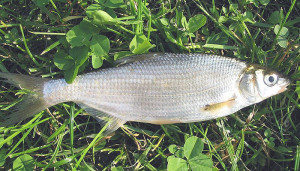 Vimba or vimba bream is a species closely related to breams, yet different by the shorter anal fin (15-22 branched rays), the pronounced scaled dorsal keel past the dorsal fin, and the downward mouth. Its back is bluish gray, the belly is silver white, and the pectoral, pelvic and anal fins are primrose. In the spring prior to spawning, the vimba has its coloration intensified thus becoming one of the most spectacular freshwater fish of the European part of the former USSR. The back darkens, and the mid-belly, pectoral and anal fins grow red, and males get pearly rash on their heads next to opercula and on the scale tips. Its common names differ from west to south of Europe. Vimba grow 50 cm long, reaching maturity 4-5 years of age. The fish does upstream for spawning, and lays its eggs in rifts with rocky or gravelly soil. Spawning sites are 0.5-0.8 m deep with currents of 0.7-0.8 m/sec. Vimba breams ready to spawn enter the site simultaneously in small groups. A female is usually escorted by 5-7 males. Females move fast choosing spots for laying eggs. The spawning is most active in the morning and evening hours (5-12 and 16-24). Spawning stops with the nightfall, and the fish withdraws from the waterfront. The spawning sites are dominated by males. While vimba spawn, the same sites have schools of bleaks, minnows and gobies. According to observations, they only eat the roe that stays on the upper sides of rocks. Usually roe drifts under the rocks. Often, on the side up the current the roe is placed in a thick layer, like turf. These strong batches form due to the considerable concentrations of layers, as well as to the fact that roe from different females is carried into the same holes and cracks. The batches of roe are packless and well-rinsed. In the wild, fry forage on small invertebrates, and adults prey on various ground invertebrates – mollusks, worms, crustaceans; larger vimba readily hunt fish. Both subspecies are commercially valued. Their flesh – particularly when cured or smoked – is delicious. It is a secondary commercial fish of the Pskov-PeipsiLake.
Vimba or vimba bream is a species closely related to breams, yet different by the shorter anal fin (15-22 branched rays), the pronounced scaled dorsal keel past the dorsal fin, and the downward mouth. Its back is bluish gray, the belly is silver white, and the pectoral, pelvic and anal fins are primrose. In the spring prior to spawning, the vimba has its coloration intensified thus becoming one of the most spectacular freshwater fish of the European part of the former USSR. The back darkens, and the mid-belly, pectoral and anal fins grow red, and males get pearly rash on their heads next to opercula and on the scale tips. Its common names differ from west to south of Europe. Vimba grow 50 cm long, reaching maturity 4-5 years of age. The fish does upstream for spawning, and lays its eggs in rifts with rocky or gravelly soil. Spawning sites are 0.5-0.8 m deep with currents of 0.7-0.8 m/sec. Vimba breams ready to spawn enter the site simultaneously in small groups. A female is usually escorted by 5-7 males. Females move fast choosing spots for laying eggs. The spawning is most active in the morning and evening hours (5-12 and 16-24). Spawning stops with the nightfall, and the fish withdraws from the waterfront. The spawning sites are dominated by males. While vimba spawn, the same sites have schools of bleaks, minnows and gobies. According to observations, they only eat the roe that stays on the upper sides of rocks. Usually roe drifts under the rocks. Often, on the side up the current the roe is placed in a thick layer, like turf. These strong batches form due to the considerable concentrations of layers, as well as to the fact that roe from different females is carried into the same holes and cracks. The batches of roe are packless and well-rinsed. In the wild, fry forage on small invertebrates, and adults prey on various ground invertebrates – mollusks, worms, crustaceans; larger vimba readily hunt fish. Both subspecies are commercially valued. Their flesh – particularly when cured or smoked – is delicious. It is a secondary commercial fish of the Pskov-PeipsiLake.
/ * The photos at lake.peipsi.org are cross-posted from commons.wikimedia.org and are used for familiarization purposes only. No commercial use of the photos is allowed. For more information about to use the photos see the originals on commons.wikimedia.org. /


